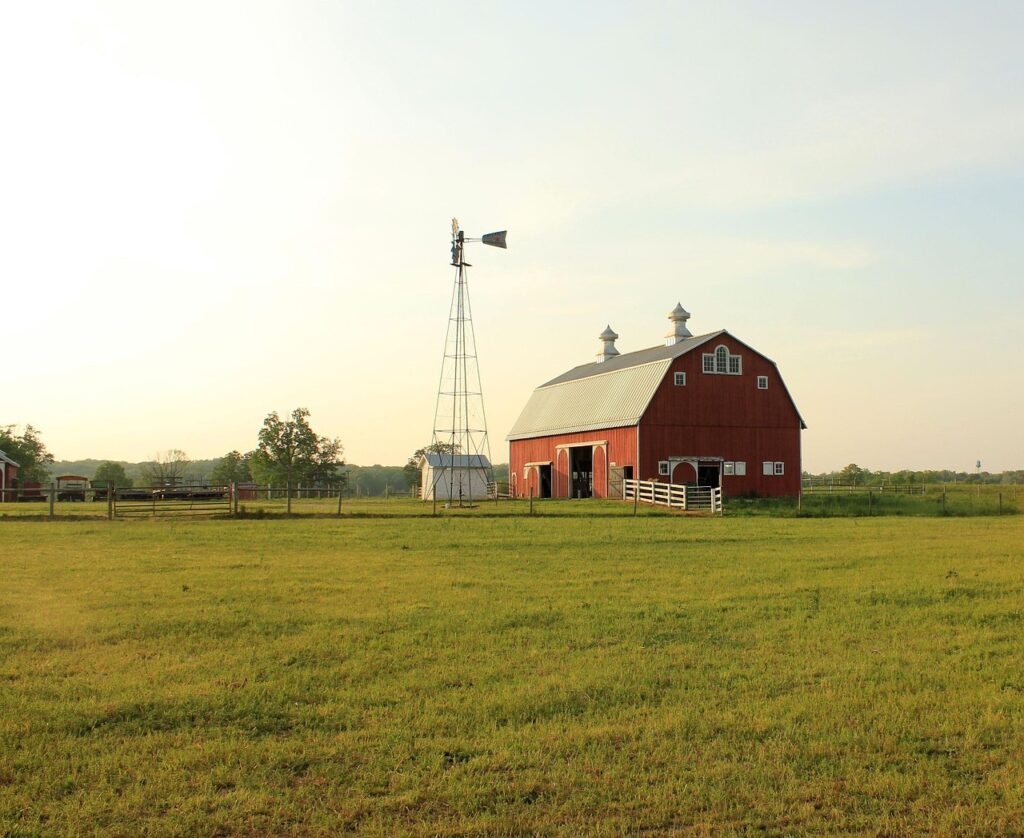By now, many people know that metal pole barns are versatile, durable, and cost-effective structures, which is why they have gained popularity in various applications. They are widely used for agricultural, industrial, residential, and recreational purposes. This is a well-known fact.
Their unique design and material composition make them ideal for those seeking functional and long-lasting buildings. Understanding the essentials of metal pole barns can help you make informed decisions.
What Are Metal Pole Barns?
A metal pole barn is a type of post-frame construction that relies on large poles or posts as its primary structural framework. These poles are either embedded directly into the ground or mounted onto concrete piers, creating a stable and durable foundation. The structural design eliminates the need for extensive excavation or a full concrete slab, making construction faster and more cost-effective. The walls and roof of metal pole barns are typically made of metal panels, which enhance the structure’s durability, resistance to weather, and low maintenance requirements. This combination of simplicity and strength makes metal pole barns a popular choice for various applications.
The concept of pole barns has its roots in agricultural settings, where farmers required affordable yet reliable structures to meet their needs. Traditionally made with wooden posts and siding, these barns were used to house livestock, store farm equipment, and protect crops from the elements. As technology advanced, the incorporation of metal materials revolutionized the design, improving durability, longevity, and weather resistance. Metal panels replaced wooden siding, offering protection against rot, pests, and moisture damage, while also requiring less maintenance. Today, metal pole barns continue to evolve, offering a range of sizes, styles, and features to suit diverse needs.
Modern metal pole barns have transcended their agricultural origins and are now widely used in residential, commercial, and industrial settings. They serve as garages, workshops, storage units, retail spaces, and even homes. Their versatility is enhanced by the flexibility of post-frame construction, which allows for open floor plans and easy customization. With the ability to adapt to various climates, budgets, and design preferences, metal pole barns have become a preferred option for those seeking a durable and cost-effective solution for their building needs. This widespread appeal highlights the enduring value and functionality of metal pole barn designs.
Advantages of Metal Pole Barns
1. Durability and Longevity
Metal pole barns are renowned for their strength and ability to withstand harsh weather conditions. The metal panels resist rot, warping, and pest infestations, making them a superior choice compared to wood. Additionally, metal is non-combustible, offering increased fire resistance and safety.
Properly constructed and maintained, a metal pole barn can last for decades. The combination of high-quality metal materials and a sturdy post-frame foundation ensures that these structures remain reliable for years, even with minimal upkeep.
2. Cost-Effectiveness
One of the most appealing features of metal pole barns is their affordability. The post-frame construction method reduces the need for extensive excavation and a concrete foundation, lowering initial costs. Metal panels are also widely available and relatively inexpensive compared to other building materials.
Additionally, the low maintenance requirements of metal pole barns contribute to long-term cost savings. Unlike wood, which requires frequent painting and treatment, metal components need only occasional inspections and cleaning to maintain their appearance and performance.
3. Versatility and Customization
Metal pole barns are highly adaptable to various needs and purposes. Whether you need a barn for storage, a workshop, or even a residential space, these structures can be customized to meet your requirements. You can choose from various sizes, roof styles, and color options to match your aesthetic preferences.
Moreover, the open floor plans of metal pole barns provide maximum usable space without the need for interior load-bearing walls. This flexibility allows for easy modifications or expansions in the future.
Key Components of a Metal Pole Barn
1. Posts and Foundation
The poles or posts are the backbone of a pole barn, providing structural support and stability. These posts are typically made of treated wood or steel and are embedded directly into the ground or anchored to concrete piers. This foundation design allows the structure to distribute weight evenly, making it resilient against shifting soil or high winds.
2. Metal Panels
The walls and roof of a metal pole barn are made from metal panels, usually steel or aluminum. These panels are coated with protective finishes to resist rust, corrosion, and UV damage. The interlocking design of metal panels creates a watertight seal, ensuring the barn remains weatherproof.
3. Trusses and Roofing
Trusses are horizontal support structures that span the width of the barn, supporting the roof and distributing weight evenly across the poles. Metal pole barns often feature gable or gambrel roof styles, both of which allow for efficient water drainage and snow shedding.
Common Uses for Metal Pole Barns
1. Agricultural Applications
Metal pole barns are a staple in farming and agriculture. They are used to store equipment, house livestock, and protect crops from the elements. Their spacious interiors and customizable designs make them ideal for creating barns, silos, and feed storage facilities.
2. Residential Uses
Homeowners increasingly turn to metal pole barns for garages, workshops, and even primary residences. With proper insulation and interior finishes, these structures can be transformed into comfortable living spaces or hobby areas.
3. Commercial and Industrial Uses
Businesses utilize metal pole barns for warehouses, retail spaces, and manufacturing facilities. Their open layouts and durable construction make them suitable for storing inventory, operating machinery, or creating office spaces.
Design Considerations for Metal Pole Barns
1. Size and Layout
The size of your metal pole barn will depend on its intended use. For agricultural purposes, a larger structure may be necessary to accommodate equipment or livestock. For residential or commercial applications, you may want to consider specific layouts that maximize functionality.
2. Insulation and Ventilation
Insulation is crucial for maintaining a comfortable interior temperature and preventing condensation inside the barn. Metal pole barns can be insulated with foam, fiberglass, or reflective insulation, depending on your budget and climate. Adequate ventilation is also essential to ensure proper airflow and prevent moisture buildup.
3. Aesthetic Features
While functionality is often the priority, you can also customize the appearance of your metal pole barn. Choose from a variety of colors, panel finishes, and roof styles to match your preferences. Adding features like windows, skylights, or decorative trim can further enhance the barn’s aesthetic appeal.
Maintenance Tips for Metal Pole Barns
Although metal pole barns require less maintenance than traditional wooden structures, regular upkeep is still necessary to ensure their longevity. Here are some tips for maintaining your barn:
- Inspect for Damage: Regularly check for signs of rust, corrosion, or structural damage. Addressing issues early can prevent more significant problems down the line.
- Clean Metal Panels: Remove dirt, debris, and stains from the metal panels using mild detergent and water. Avoid abrasive cleaners that could damage the protective coating.
- Check Fasteners and Seals: Tighten loose fasteners and replace worn-out seals to maintain the barn’s weatherproofing.
- Protect Against Moisture: Ensure proper drainage around the foundation to prevent water accumulation and potential damage to the posts or concrete piers.
Environmental Benefits of Metal Pole Barns
Metal pole barns are an eco-friendly choice for construction due to their use of sustainable materials. The steel and aluminum commonly used in these buildings are often sourced from recycled materials, reducing the need for raw material extraction and lowering the environmental impact. Moreover, at the end of their lifespan, these materials are 100% recyclable, meaning that dismantled metal panels and structural components can be repurposed into new products. This closed-loop recycling process helps minimize waste and supports a more sustainable construction industry.
Beyond the materials themselves, metal pole barns are designed with energy efficiency in mind. Many feature reflective roof coatings that help deflect sunlight, reducing heat absorption and keeping the interior cooler during hot weather. This can significantly lower cooling costs and reduce the building’s overall energy consumption. Additionally, insulation options, such as spray foam or rigid panels, can be incorporated to enhance thermal performance, making the structure more comfortable and efficient year-round. These energy-saving features align with environmentally conscious practices, benefiting both the owner and the planet.
The eco-friendly benefits of metal pole barns extend to their construction process. Unlike traditional building methods, post-frame construction minimizes material waste and requires fewer resources, such as concrete and lumber. The efficiency of the building process also reduces the energy and labor needed for assembly. When combined with their durability and low maintenance requirements, metal pole barns represent a sustainable investment that supports long-term environmental goals while meeting the practical needs of modern construction.
Building Codes and Permits
Before constructing a metal pole barn, familiarize yourself with local building codes and permit requirements. These regulations may dictate the barn’s size, placement, and construction methods. Working with a professional contractor can help ensure your barn complies with all necessary codes.
Conclusion
Metal pole barns offer a durable, cost-effective, and versatile solution for various construction needs. Their unique post-frame design and metal components make them ideal for agricultural, residential, and commercial applications. With proper planning, customization, and maintenance, a metal pole barn can serve as a reliable and long-lasting addition to your property. By understanding the key aspects of these structures, you can confidently invest in a metal pole barn that meets your specific needs and preferences.

